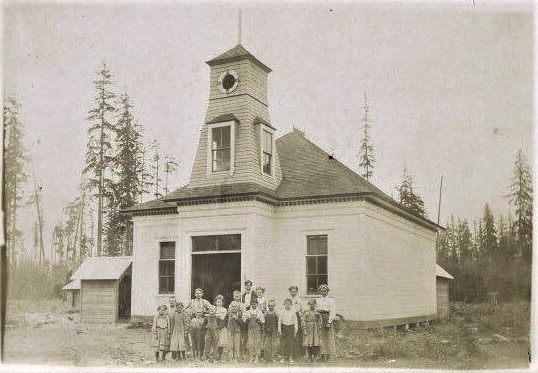Nestled below the forest of Tenino Park and next to the Tenino Depot Museum is a one-room schoolhouse called Ticknor School. It’s worth a visit to Tenino to experience the best intact one-room school house in Thurston County complete with desks and a pot belly stove. The school began its life serving a remote pioneer farming community on the Skookumchuck Valley Road.
The Skookumchuck Valley with its fertile river land was attractive to early settlers who were looking to take advantage of the Donation Land Claim Act. Land that was easy to farm not only made subsistence survival easier, but also contributed to the fulfillment of the Donation Land Claim Act’s requirements, which allowed homesteaders to cultivate and live on land for four years to own it outright.
Some of the early settlers of Skookumchuck Valley were the Frost, Davis, Prince, Yantis, Northcraft, and Ticknor families. Many of these families had children who attended Ticknor School and many of their descendants still live in the valley today.
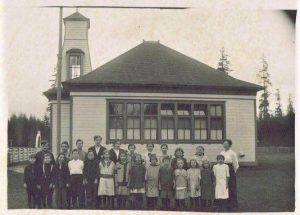
Ticknor School is named for Joel and Elizabeth (Ford) Ticknor. Lizzie Ford came west with her parents, Sidney and Nancy Ford, in 1845 as a tiny four-year old and settled on Ford’s Prairie in Centralia. She spent her childhood in the wild Pacific Northwest learning to ride bareback ponies, playing with the Native American children and learning their language. She married Joel Ticknor when she was 15-years-old and moved to their homestead of 320 acres in the Skookumchuck Valley. Joel, though a farmer, served during the Indian Wars of 1855-1856. Joel and Elizabeth had 10 children.
Life in the Skookumchuck Valley could be lonely and remote as it’s a road to nowhere. Because of this, folks who lived in the valley kept the one-room schoolhouse system going when its era was past elsewhere.
Life of a One-Room Schoolhouse
Accounts within the museum do not agree regarding the historical timeline of the Ticknor School. What is fact is that the current Ticknor School was constructed next to the present Skookumchuck Fire Station around 1932.
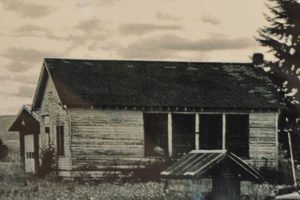
Before the construction of the Ticknor School, there are tales of classes in various homes: in Flora Turveys’ kitchen on Coal Road, in the attic of Jonathan Prince, and at the Davis home on Skookumchuck Road.
The first Ticknor School was built in 1883 across the street from the grange hall. One story is that the original school was burned and rebuilt in 1912 and then the second school burned, leading to the construction of the third. Another story is that the original school was actually moved in 1896 to the location next to the firehall. In photographs, the two building do look remarkably similar with the later addition of windows. After the fire in 1932, it is firm fact that the current Ticknor School was built and closed in 1936 when the school was consolidated into Stony Point School.
The one-room schoolhouse was a way of life for many pioneer children. The terms were shorter than they are today and ranged in length from three to five months of the year.
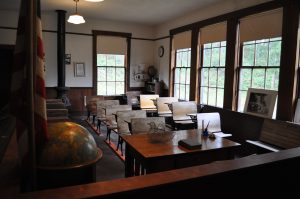
What was expected of a teacher in a one-room school house went well beyond today’s job description. Teachers were expected to haul firewood for the little pot belly stove and act as janitor. Some made soup for the children on top of the little pot belly stove. Students ranged in age from 6 to 15 years old with subjects covering first through eighth grade levels. A teacher needed to be dynamic enough to accommodate them all. Teachers were also generally unmarried and boarded with a neighboring family. The quality of the boarding situation was possibly more important than the salary. Poor boarding was most likely the cause of more than one school’s inability to retain teachers. Regardless of the situation, it was uncommon for a teacher to remain at a school for more than a couple years. If they didn’t marry, they moved around from school to school, sometimes just down the road.
In fact, schools were only four or five miles apart since many of the students had to walk to school before the advent of school buses. Without plumbing or electricity, amenities in most schools included a pot belly stove for heat and an outhouse.
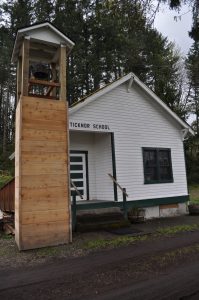
A School on the Move
With many original schoolhouse features still intact, the South Thurston County Historical Society worked tirelessly to preserve and move Ticknor School to the Tenino Depot Museum grounds. Extensive fundraising and donations of time and equipment enabled the school to begin its journey. In addition to the move, the school required a new roof and new walls. On Sunday, August 18, 2002, Ticknor School was moved over the span of six hours from 5405 Skookumchuck Valley Road to the site of the Tenino Depot Museum. Without the move, Ticknor School would have been destroyed by a planned burn since it remained virtually unused except for fire station storage since its closure in 1936.
The recent addition of the nearly finished bell tower completes the scene of the long ago one-room schoolhouse, with perhaps the omission of the outhouse. All that’s missing is for teachers Miss Case or Miss Campbell to ring the bell and declare school in session.
The Ticknor School and the Tenino Depot Museum are open Saturday and Sunday noon to 4:00 p.m. April through October. You can take a virtual tour of the school here.









































